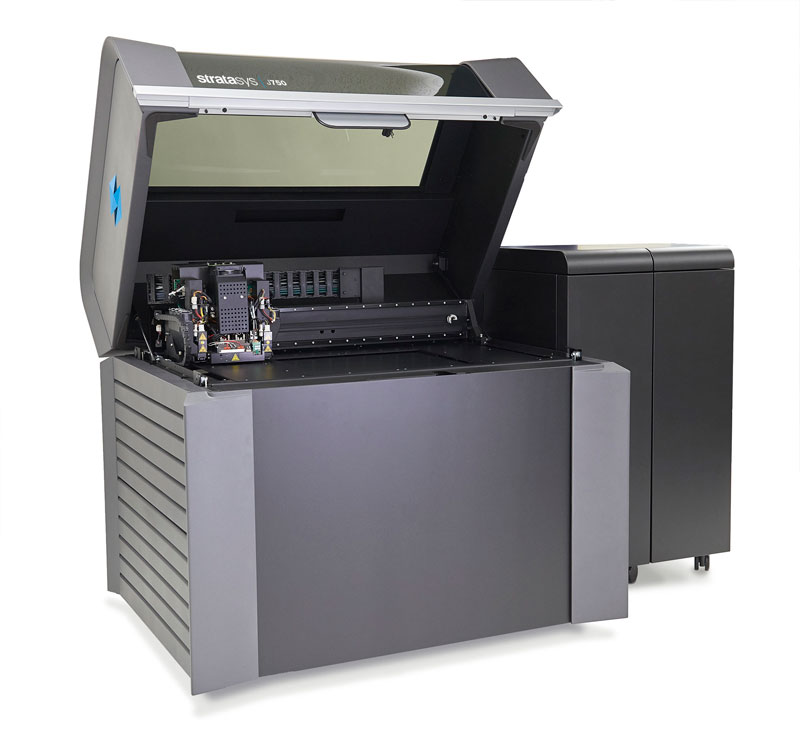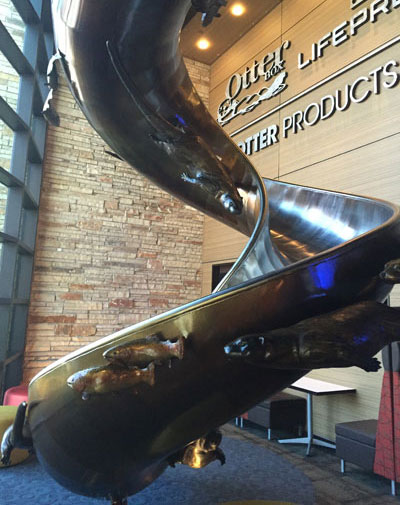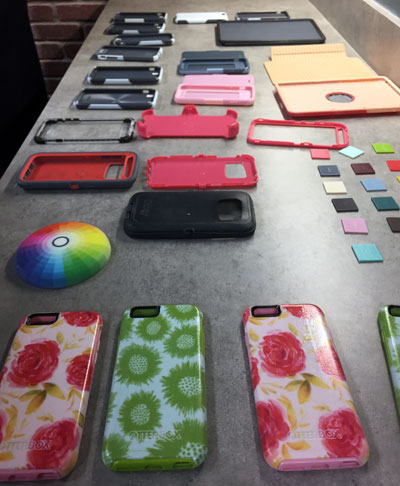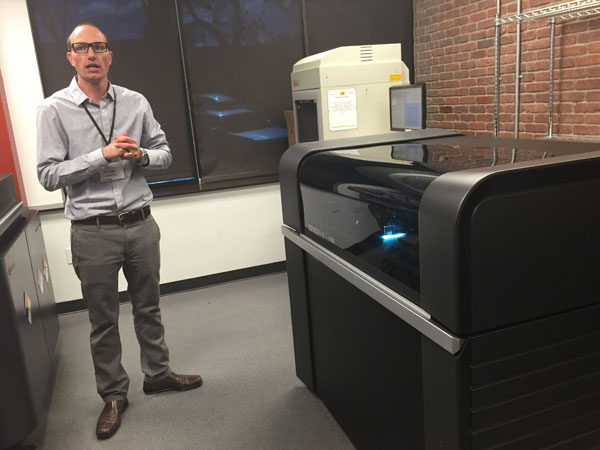OtterBox Speeds Product Development with the New Stratasys J750 3D Printer

The Stratasys J750 multi-material, full-color 3D printer features a six-cartridge material capacity to keep the most used resins loaded. Image courtesy of Stratasys.
Latest News
April 4, 2016
 The Stratasys J750 multi-material, full-color 3D printer features a six-cartridge material capacity to keep the most used resins loaded. Image courtesy of Stratasys.
The Stratasys J750 multi-material, full-color 3D printer features a six-cartridge material capacity to keep the most used resins loaded. Image courtesy of Stratasys. This otter sculpture/slide winds its way down from the second floor into the lobby of the OtterBox headquarters in Fort Collins, CO.
This otter sculpture/slide winds its way down from the second floor into the lobby of the OtterBox headquarters in Fort Collins, CO.Perhaps not surprisingly, there are otters everywhere at OtterBox, the mobile phone and tablet case maker based in Fort Collins, CO. Framed otter photographs adorn the walls, an otter statue stands outside a conference room and a spiral slide sculpture — complete with bronze otters and fish — winds down from the second floor into the lobby. Many of the journalists that Stratasys flew in for a press event last week took a ride on that slide (including me), but we weren’t there for the otters. We were there to see Stratasys’ latest 3D printer, the J750, in action. (For details, see Desktop Engineering's article “Stratasys Launches the J750 3D Printer and PolyJet Studio Software” here.)
It’s not all fun and otters at OtterBox. Making the No. 1 selling case for smartphones means molding millions of parts every day in the company’s facilities in the U.S., China and Mexico. New device launches, like the latest iPhone, often dictate the company’s tight production deadlines.
Racing to Retail
“Our main goal is to supply all the resources possible for the engineers to get their product onto the peg at the same time, if not before the device we’re making that product for launches,” said Brycen Smith, engineering technician supervisor at OtterBox, during his presentation at the company’s headquarters. “The J750 plays a huge role in that — not only from ideation and creation, but into our approval processes … really developing those new products, the new technologies, the new innovations OtterBox is known for.”
The company typically has eight weeks to design cases for a new device to get them “on the peg” (hanging up in the store) after it receives the CAD geometry for the device. Within the first 24 hours, OtterBox is 3D printing what it calls “feature location verification prints.” These first prototypes serve to precisely locate all of the features on the device — screen, power, volume, charging port, camera, speakers, etc. — to ensure the case functions flawlessly, said Smith. He says they usually 3D print five to 12 iterations of the location prints in an 8-hour day.
 The Stratasys J750 on-site at OtterBox, closed and open.
The Stratasys J750 on-site at OtterBox, closed and open. An assortment of prototypes created by OtterBox on the Stratasys J750 3D printer.
An assortment of prototypes created by OtterBox on the Stratasys J750 3D printer.Having a realistic prototype is critical to ensure focus groups and company decision makers can see and feel what the final case will really look like. They’re also sent to the packaging team so they can design attractive packaging with a perfect fit, manufacturing and marketing, and to retailers so they know what to expect.
The prototypes leave nothing to chance. They’re a critical step in the company’s design process, which the J750 speeds up considerably. Before the design freedom made possible by multi-material, full-color 3D printing, Smith said the company’s technicians would 3D print prototypes in white and then paint each potential design to exact specifications.
“That’s one color a day per part,” he said. “So they’re painting one part, you’ve got to mask it off, wait for it to dry, paint the other color, mask it off again, paint it again, come back and do some final touches ... We can’t hit eight weeks to market doing that.”
Smith said the J750, which OtterBox has been beta testing since late 2015, matches the spectrometer (color) and durometer (hardness) specifications of the cases within final manufacturing tolerances. It allows OtterBox to accurately mimic the production parts in a fraction of the time it used to take to paint each one.
Testing and Manufacturing
The look and feel of a cellphone cover is obviously important. People interact with it several times a day and, for some, a phone case is a way to express their personality and sense of style. But a good-looking case that doesn’t protect your phone or tablet would be a design failure. OtterBox sends its cases to its PIT (Prototype, Innovate, Test) Lab to ensure they can stand up to abuse.
In the PIT Lab, various tests are performed to simulate real-world drops, exposure to chemicals (such as hand lotions and detergents), scratches, and the temperature and humidity changes a case might be subjected to. While OtterBox tests production parts, 3D printing is used to create fixtures and jigs to help the test engineers work more efficiently. For example, a jig is 3D printed to make sure the screens for the OtterBox Defender series of cases fit just right.
“When we are releasing that product into mass production, it’s dialed in exactly where we want it to be,” Smith said. “We might have 1,500 tools in production at one time, and to make one small change during tooling could affect every one of those tools.”
 Brycen Smith, engineering technician supervisor at OtterBox, said they were 3D printing parts on the Stratasys J750 the day it was delivered.
Brycen Smith, engineering technician supervisor at OtterBox, said they were 3D printing parts on the Stratasys J750 the day it was delivered.3D printing is integral to product development at OtterBox. It helps keep all its stakeholders on the same page, allows decision makers to make informed choices based on realistic prototypes and ensures manufacturing is setup correctly the first time.
“Without it, we’d be in a world of hurt,” said Smith of the Stratasys J750 3D printer. “It’s huge. Cost savings — I couldn’t even quantify it in numbers, monetarily or in days. It’s huge savings all around.”
The brief video below shows the Stratasys J750 at work as journalists tour the OtterBox facilities.
For more information, read ”Stratasys Launches the J750 3D Printer and PolyJet Studio Software” and visit the Stratasys J750 microsite.
Subscribe to our FREE magazine, FREE email newsletters or both!
Latest News
About the Author
Jamie Gooch is the former editorial director of Digital Engineering.
Follow DE





